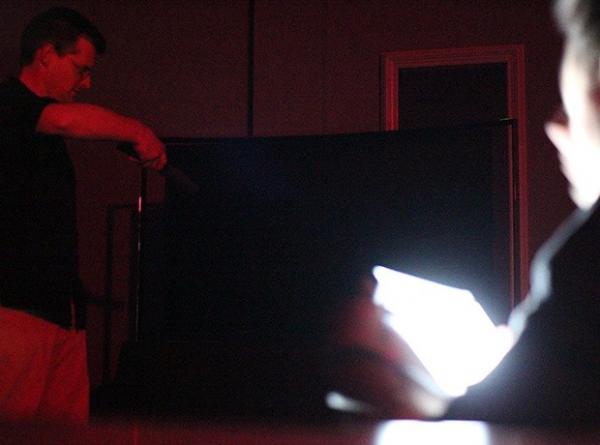This picture shows the future of television

This may not look like much, but it is a quantum leap in television performance.
In this long-exposure image (note how bright the iPad is in the foreground), you’re looking at something incredible.
That TV you see? That TV is on.
This grainy, odd-colored image was a shot I took during an all-too-brief session with Samsung’s new KN55S9C at their QA Labs in New Jersey. The exposure was 0.6 seconds, at an ISO of 6400, with a wide-open f1.4 lens. To the naked eye, you could just make out Home Theater alum (and current Samsung uberguru) Mike Wood (left), but pretty much all the light in the room was from Rob’s iPad (right).
What makes this image so fascinating is the KN55S9C is actually displaying an image. Using his Sencore test pattern generator, Al Griffin (out of frame on the left) is sending the TV a 0 IRE black signal.
If this same setup was done with even the best plasmas, you’d still see some light coming from the TV. Plasmas creating “black” still have some energy in their pixels. With OLED, the pixels can be true black: the absence of light. Well, OK, technically, they’re not the "absence" of light, but they’re just about as close as you’ll ever see.
Owners of most LED LCDs might be curious what the big deal is. After all, most LED LCDs cut to black when given a 0 IRE signal. This is true, but they’re cheating. They’re shutting off their LEDs. Put up any sort of image (even a tiny, low brightness test pattern), and the LEDs kick back on and the black level goes WAY up.
That’s not the case with OLED. The black level you see in this image is basically the exact same if you put any sort of image on screen. Black letterbox bars? This dark. The space between a shot of the stars? That dark. The contrast ratio is several orders of magnitude better than any display you’ve ever seen. Including CRT.
Because on the other side of the foot-lambert is how bright the TV is. Easily brighter than any plasma, and as bright or brighter than many LED LCDs (though some of the latter are even brighter). This combination is figuratively (almost literally) stunning to look at. Imagine black letterbox bars that are too dark to see, with the 2.35:1 image popping over 100 ftL.
There are lots of questions you (and we) have. We hope to answer as many as we can in our upcoming reviews. Al’s writing up the KN55S9C as you read this (back to work, Al!), and Tom Norton is scheduled to get the LG 55EA9800 soon. These two OLED TVs really are the next generation of televisions. It’s an exciting time to be a videophile.
To tide you over for a bit, here’s Rob, Al, and my thoughts from the time we spent with the KN55S9C last week.
Editor Rob:
“My initial impression with the limited calibration and viewing session we had with the Samsung was one of excitement. The set wasn't without some detectable flaws, and it's expensive for what you get. But this execution shows that OLED can deliver accurate color on film-based content (something never proven to me at any trade show demo) while delivering a level of contrast that is absolutely mesmerizing. I can't wait for it to get even better…and bigger…and cheaper.”
Al:
"My first hands-on with OLED was almost a disappointment. Why? Because Samsung's TV passed nearly every point on the picture-quality checklist, including black-level, color accuracy, and detail. There wasn't a serious flaw I could hammer it on! The image put out by the set, while not perfect (more on that to come) proves that OLED is capable of satisfying the core requirements of serious videophiles. I look forward to seeing it in a flatter — and less pricey — package in 2014, but for first-gen tech this is pretty great."
Me:
"As an unabashed fanboy of OLED, I’m practically giddy that we finally have TVs to check out. Is the KN55S9C better than the current king of picture quality, the Panasonic ZT60? Yes, it sure seems like it. It’s better than the vaunted Kuro, too. Sure if you take price and size into consideration, it’s hard to make a logical case for either OLED. But that doesn’t matter. No one is saving up to buy a $9,000, 55-inch OLED. Hopefully the people who can slap a few of these on their AmEx Black card can drive the price down for the rest of us. Maybe at CES we’ll see 65-inch models for even less money. And then 75, 85, 95..."
Bottom Line
Sure the new OLEDs are $9,000 and $15,000, but this is a new technology. These prices will come down to where the rest of us can afford them. Sizes will go up too. For more info about the launch and these TVs, check out OLED Begins.






























































